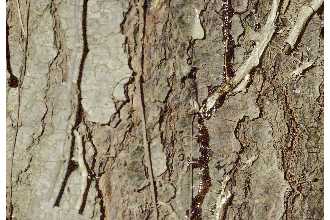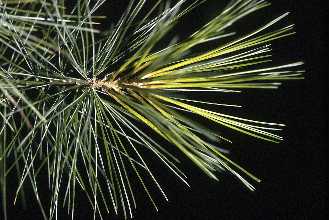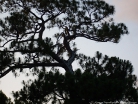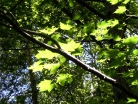



Eastern White Pine is the state tree of several states. Maine made it theirs in 1945. Of all the native conifers calling eastern North America home, this tree is the tallest. It towers at 150 feet and lives as long as 450 years-sometimes longer. It most likely used to grow even taller and older before the colonist arrived. The current champion in Maine is 120 feet tall, has a trunk circumference of 245 inches, and a crown spread of 80 feet! Last measured in
State Tree: Eastern White Pine


Maine

Want to add your tree to our picture gallery? Click here for details!
-Color denotes a tree that is rare or endangered

Photo citation: Robert H. Mohlenbrock USDA NRCS 1995. Northeast wetland flora; Field office guide to plant species. Northeast National Technical Center, Chester
Native Trees of Maine
Teapot by TreesForMe
Visit the Image Shop for more nature inspired products.
Visit the Image Shop for more nature inspired products.



™

Thursday, May 22, 2025

Custom Search
Home>Browse by State>Maine

Tree lists:
•A-Z by scientific
name
•A-Z by common
name
•By Family
For state A-Z list click state name below.
•A-Z by scientific
name
•A-Z by common
name
•By Family
For state A-Z list click state name below.
We are part of the Hubpages community.
Click here for more info.
Click here for more info.
We are part of the Hubpages community.
Click here for more info.
Click here for more info.
With over 80% of its land forested, Maine
is one of the best places to lose yourself in the quiet woods. Pine, maple, beech, birch and oak are some of the more common tree species that make up Maine's forests. One of the best ways to enjoy the scenery is hiking through the many trails throughout the state. In fact, Maine has partnered with Center for Community GIS of Farmington to create a database of all state trails. Housing some of the trails are Maine's 32 state parks and Acadia National Park, the only National Park in New England. Acadia National Park is unique among
is one of the best places to lose yourself in the quiet woods. Pine, maple, beech, birch and oak are some of the more common tree species that make up Maine's forests. One of the best ways to enjoy the scenery is hiking through the many trails throughout the state. In fact, Maine has partnered with Center for Community GIS of Farmington to create a database of all state trails. Housing some of the trails are Maine's 32 state parks and Acadia National Park, the only National Park in New England. Acadia National Park is unique among

Maine Native Tree Facts

Forested acres: 17.7 million
Percent of total area forested: 82%
Predominant Forest Type: maple-beech-yellow birch, spruce-fir
Number of National Forests: 1
Number of State Parks: 32
Number of Tree city USA communities: 18
Number of invasive tree species: 8 (see state list for noxious/invasive plants)
Insects of Concern: Emerald Ash Borer, Asian Longhorned Beetle, European Wood Wasp, Hemlock Wooly adelgid
Pathogens of Concern: Dutch Elm Disease, Sudden Oak Death
Number or Rare, Threatened or Endangered Species: 23
Number of tree families in our collection: 25
Sources:
Arborday.org
US Forest Service
Maine.gov
Maine Secretary of State
United States Department Of Agriculture, Natural Resources Conservation Services: PLANTS Database
Additional state resources:
Maine Forest Service
Maine Trail Finder
University of Maine, Cooperative Extension Service
Percent of total area forested: 82%
Predominant Forest Type: maple-beech-yellow birch, spruce-fir
Number of National Forests: 1
Number of State Parks: 32
Number of Tree city USA communities: 18
Number of invasive tree species: 8 (see state list for noxious/invasive plants)
Insects of Concern: Emerald Ash Borer, Asian Longhorned Beetle, European Wood Wasp, Hemlock Wooly adelgid
Pathogens of Concern: Dutch Elm Disease, Sudden Oak Death
Number or Rare, Threatened or Endangered Species: 23
Number of tree families in our collection: 25
Sources:
Arborday.org
US Forest Service
Maine.gov
Maine Secretary of State
United States Department Of Agriculture, Natural Resources Conservation Services: PLANTS Database
Additional state resources:
Maine Forest Service
Maine Trail Finder
University of Maine, Cooperative Extension Service
Maine Native Tree Families and Genera

Useful information while browsing species:
• How to read a botanical name
• How to use our species boxes:
• How to read a botanical name
• How to use our species boxes:
Additional Resources:
North American Native Tree Families
North American A to Z List by Scientific Name
North American A to Z List by Common Name
North American Native Tree Families
North American A to Z List by Scientific Name
North American A to Z List by Common Name
click to enlarge.
-Color denotes a tree that is rare or endangered

Please note: This is not a complete list of all native tree families and species found in Maine. We are constantly working towards a more comprehensive list and will add families and their species as completed.
Follow the links to view species native to Maine. If the genus is not linked, species are listed on the family page.
Aceraceae, Maple
Anacardiaceae, Sumac
Rhus, Sumac
Toxicodendron, Poison Sumac
Betulaceae, Birch
Betula, Birch
Carpinus, Hornbeam
Corylus, Hazelnut
Ostrya, Hophornbeam
Bignoniaceae, Trumpet Creeper
Caprifoliaceae, Honeysuckle
Cornaceae, Dogwood
Cornus, Dogwood
Nyssa, Tupelo
Cupressaceae- Cypress
Chamaecyparis, Cedar
Juniperus, Juniper
Thuja, Arborvitae
Aceraceae, Maple
Anacardiaceae, Sumac
Rhus, Sumac
Toxicodendron, Poison Sumac
Betulaceae, Birch
Betula, Birch
Carpinus, Hornbeam
Corylus, Hazelnut
Ostrya, Hophornbeam
Bignoniaceae, Trumpet Creeper
Caprifoliaceae, Honeysuckle
Cornaceae, Dogwood
Cornus, Dogwood
Nyssa, Tupelo
Cupressaceae- Cypress
Chamaecyparis, Cedar
Juniperus, Juniper
Thuja, Arborvitae
Ericaceae, Heath
Fabaceae, Pea
Gleditsia, Locust
Fagaceae, Beech
Quercus, Oak
Hamamelidaceae, Witch-hazel
Hippocastanaceae, Horse-chestnut
Juglandaceae, Walnut
Carya, Hickory
Juglans, Walnut
Lauraceae, Laurel
Magnoliaceae, Magnolia
Myricaceae, Bayberry
Oleaceae, Olive
Fraxinus, Ash
Pinaceae, Pinus
Abies, Fir
Pinus, Pine
Fabaceae, Pea
Gleditsia, Locust
Fagaceae, Beech
Quercus, Oak
Hamamelidaceae, Witch-hazel
Hippocastanaceae, Horse-chestnut
Juglandaceae, Walnut
Carya, Hickory
Juglans, Walnut
Lauraceae, Laurel
Magnoliaceae, Magnolia
Myricaceae, Bayberry
Oleaceae, Olive
Fraxinus, Ash
Pinaceae, Pinus
Abies, Fir
Pinus, Pine
Platanaceae, Plane-tree
Platanus, Sycamore
Rosaceae, Rose
Crataegus, Hawthorn
Rubiaceae, Madder
Rutaceae, Rue
Salicaceae, Willow
Populus, Cottonwood
Salix, Willow
Tiliaceae, Lindon
Tilia, Basswood
Ulmaceae, Elm
Celtis, Hackberry
Ulmus, Elm
Platanus, Sycamore
Rosaceae, Rose
Crataegus, Hawthorn
Rubiaceae, Madder
Rutaceae, Rue
Salicaceae, Willow
Populus, Cottonwood
Salix, Willow
Tiliaceae, Lindon
Tilia, Basswood
Ulmaceae, Elm
Celtis, Hackberry
Ulmus, Elm
• Limit of range- edge of distribution or disjunct from main distribution.
• Population declining- seriously declining due to habitat modification or destruction, or from over collection for commercial,
recreational, or educational purposes.
• Population vulnerability- highly vulnerable to decline due to location or human usage.
Once a species is determined to fall into one of the above categories, it is then assigned rarity status by the state of as
defined:
• Endangered- Rare and in danger of being lost from the state in the foreseeable future, or federally listed as Endangered.
• Threatened- Rare and, with further decline, could become endangered; or federally listed as Threatened.
• Special Concern- Rare in Maine, based on available information, but not sufficiently rare to be considered Threatened or
Endangered.
• Possibly Extirpated- Not known to currently exist in Maine; not field-verified (or documented) in Maine over the past 20 years.
Rare tree species present in Maine (see related links for full list):
Special Concern:
Betula pumila, Swamp birch
Castanea dentata, American chestnut
Chamaecyparis thyoides, Atlantic white-cedar
Sassafras albidum, Sassafras
Threatened:
Quercus bicolor, Swamp white oak
Quercus montana, Chestnut oak
Salix myricoides, Blue-leaf willow
Salix planifolia, Tea-leaved willow
Native plant species considered rare in Maine meet one or
more of the following state categories:
• Endemism- geographically restricted to the State or areas
immediately adjacent to the State.
• Few Populations- extremely small number of populations.
• Few Individuals- numerically scarce, small number of individual
plants.
• Special habitat- requiring habitat that is scarce in the State.
Maine Endangered or Threatened Tree Species

Additional Resources:
North American Rare and Endangered Trees
External Links:
USDA PLANTS Database
Full Maine Rare Plant List
North American Rare and Endangered Trees
External Links:
USDA PLANTS Database
Full Maine Rare Plant List
Looking for a nursery near you?
Check out our nursery listing by county below!
Sorry, we do not currently have any tree nursery listings for this state. We do update these lists, so please check back.
Check out our nursery listing by county below!
Sorry, we do not currently have any tree nursery listings for this state. We do update these lists, so please check back.



Endangered:
Carya cordiformis, Bitternut hickory
Cornus florida, Flowering dogwood
Prunus maritima, Beach plum
Quercus coccinea, Scarlet oak
Possibly Extirpated:
Platanus occidentalis, Sycamore
Ulmus rubra, Slippery Elm
Carya cordiformis, Bitternut hickory
Cornus florida, Flowering dogwood
Prunus maritima, Beach plum
Quercus coccinea, Scarlet oak
Possibly Extirpated:
Platanus occidentalis, Sycamore
Ulmus rubra, Slippery Elm





National Parks in that it contains mountains, lakes, rivers, ocean front and even islands! In addition to that, one of the most famous trails in all of North America, the Appalachian Trail, ends at Mount Katahdin's Baxter Peak in Baxter State Park.
Within the rugged forests of Maine lie valleys carved by ice streams passing through mountainous areas. Glacial till, or leftover sediment and gravel, can be found just about anywhere. Large rounded boulders are commonly found, seemingly out in the middle of no where, which were left behind as the glaciers retreated. Enjoying the trees and trails of Maine also means nature lovers have a chance to see the geologic history of the area. Bedrock exposures like the Knife Edge of Mount Katahdin, or wave swept bedrock at Pemaquid Point in Bristol, are a window into the Earth's violent past. While walking among some of the tallest tree species in eastern North America, you may even glimpse 500 million year old remnant lava tubes, hardened into "pillows", Metamorphic rocks created by intense heat and pressure beneath the earth's surface, or stumble upon Maine's most famous mineral- tourmaline. There are even public mines open for the latter!
The forests of Maine really do harbor giants. One of the most famous trees, Herbie, was the largest American Elm tree in New England. It reached 217 years old before succumbing to disease and was felled in 2010. The tallest tree in Maine is said to be a 135 foot tall red spruce located in Blanchard. Other state champions (2010) include a yellow poplar, standing 129 feet, and a 126 foot eastern cottonwood.
Within the rugged forests of Maine lie valleys carved by ice streams passing through mountainous areas. Glacial till, or leftover sediment and gravel, can be found just about anywhere. Large rounded boulders are commonly found, seemingly out in the middle of no where, which were left behind as the glaciers retreated. Enjoying the trees and trails of Maine also means nature lovers have a chance to see the geologic history of the area. Bedrock exposures like the Knife Edge of Mount Katahdin, or wave swept bedrock at Pemaquid Point in Bristol, are a window into the Earth's violent past. While walking among some of the tallest tree species in eastern North America, you may even glimpse 500 million year old remnant lava tubes, hardened into "pillows", Metamorphic rocks created by intense heat and pressure beneath the earth's surface, or stumble upon Maine's most famous mineral- tourmaline. There are even public mines open for the latter!
The forests of Maine really do harbor giants. One of the most famous trees, Herbie, was the largest American Elm tree in New England. It reached 217 years old before succumbing to disease and was felled in 2010. The tallest tree in Maine is said to be a 135 foot tall red spruce located in Blanchard. Other state champions (2010) include a yellow poplar, standing 129 feet, and a 126 foot eastern cottonwood.
Photo citation: Robert H. Mohlenbrock USDA NRCS 1995. Northeast wetland flora; Field office guide to plant species. Northeast National Technical Center, Chester
2001, this giant from the 2010 Big Tree Registry is located in Morill.
Eastern white pine's bark is smooth and gray on young trees, becoming broken into small plates when mature. The root system is deep, 40 inches or so, with spreading laterals and has no distinct tap root. The needles are 3-5 inches long, bundled in 5's and
Eastern white pine's bark is smooth and gray on young trees, becoming broken into small plates when mature. The root system is deep, 40 inches or so, with spreading laterals and has no distinct tap root. The needles are 3-5 inches long, bundled in 5's and
dark green. They are soft, flexible, fine and persist to the second year. Beginning at age 5-10, curved, 4-8 inch long spine free cones start growing. Male strobili open and disperse pollen from April to June, depending on location. It will take 2 years for cones to mature. Seeds are typical of pines in their small size, .08 inches, brown color and single winged. Dispersal is from August to September.
Learn More
Learn More
The Pine Tree State, 'I lead'
|
|
|
|
|
| A-Z scientific | ||
| A-Z by Common Name | ||
| Families | ||
| Browse by State | ||
| Rare or Endangered Species | ||
| Trees_with_Special_Uses | ||
| Tallest and Biggest |
| Aceraceae Maple Family | ||
| Anacardiaceae Sumac Family | ||
| Annonaceae Custard Apple Family | ||
| Aquifoliaceae Holly Family | ||
| Arecaceae, Palm Family | ||
| Betulaceae Birch family | ||
| Bignoniaceae Trumpet Creeper Family | ||
| Burseraceae Frankincense Family | ||
| Caprifoliaceae Honeysuckle Family | ||
| Chrysobalanaceae Coco-plum Family | ||
| Cornaceae Dogwood Family | ||
| Cupressaceae Cypress Family | ||
| Cyrillaceae Cyrilla Family | ||
| Ebenaceae Ebony Family | ||
| Ericaceae Heath Family | ||
| Fabaceae Pea Family | ||
| Fagaceae Beech Family | ||
| Hamamelidaceae Witch Hazel Ffamily | ||
| Hippocastanaceae Horse Chestnut Family | ||
| Juglandaceae Walnut Family | ||
| Lauraceae Laurel Family | ||
| Leitneriaceae Corkwood Family | ||
| Magnoliaceae Magnolia Family | ||
| Meliaceae Mahogany Family | ||
| Moraceae Mulberry Family | ||
| Myricaceae Bayberry Family | ||
| Myrsinaceae Myrsine Family | ||
| Myrtaceae Myrtle Family | ||
| Nyctaginaceae Four Oclock Family | ||
| Olacaceae Olax Family | ||
| Oleaceae Olive Family | ||
| Pinaceae Pine Family | ||
| Platanaceae Plane Tree Family | ||
| Polygonaceae Buckwheat Family | ||
| Rhamnaceae Buckthorn Family | ||
| Rosaceae Rose Family | ||
| Rubiaceae Madder Family | ||
| Rutaceae Rue Family | ||
| Salicaceae Willow Family | ||
| Sapindaceae Soapberry Family | ||
| Sapotaceae Sapodilla Family | ||
| Simaroubaceae Quassia Family | ||
| Styracaceae Storax Family | ||
| Symplocaceae Sweetleaf Family | ||
| Theaceae Tea Family | ||
| Tiliaceae Lindon Family | ||
| Ulmaceae Elm Family | ||
| Taxaceae Yew Family | ||
| Yucca Family |
| Maple A-Z |
| sumac_family_a-z |
| custard_apple_family_a-z |
| holly_trees_a-z |
| palm_family_a-z |
| birch_family_a-z |
| trumpet_creeper_family_a-z |
| honeysuckle_family_a-z |
| dogwood_family_a-z |
| cypress_family_a-z |
| heath_family_a-z |
| pea_family_a-z |
| beech_family_a-z |
| walnut_family_a-z |
| magnolia_family_a-z |
| olive_family_a-z |
| rose_family_a-z |
| willow_family_a-z |
| franklinia |
| elm_family_a-z |
| Federal List | ||
| State Lists | ||
| Invasive_species |
| Restoration of the American Chestnut | ||
| Restoration of the American Elm | ||
| Sustainable Forestry |
| Contact Us | ||
| Our Contributors | ||
| Photo of the Month | ||
| Usage Requirements | ||
| FAQ | ||
| Report a Broken Link |
| photo_submission |
| Photo Store |




